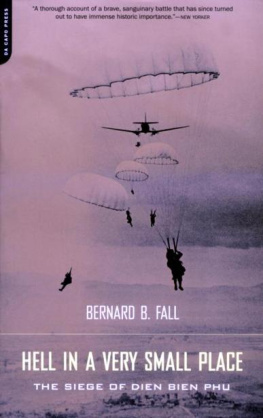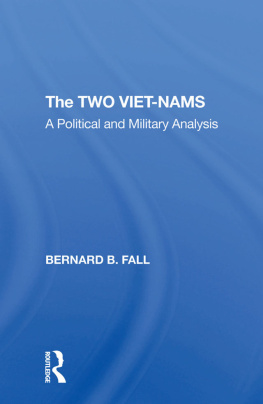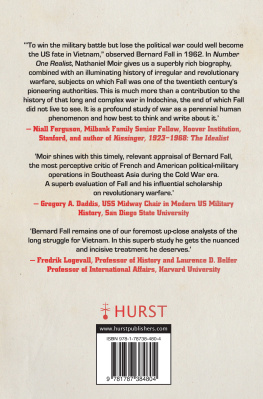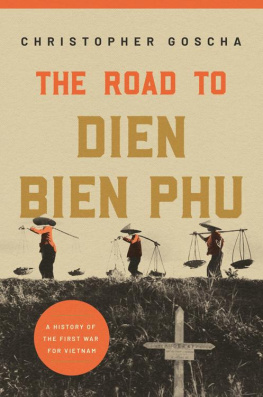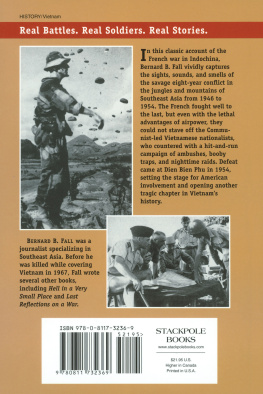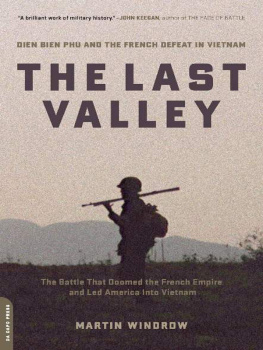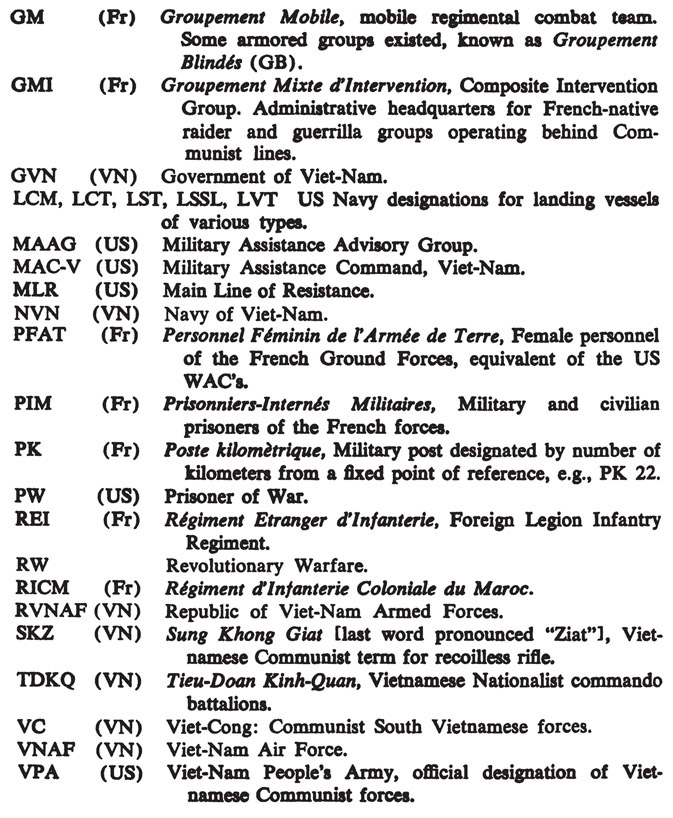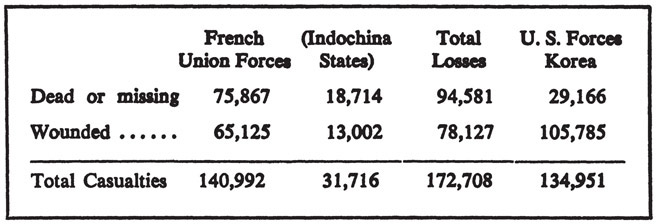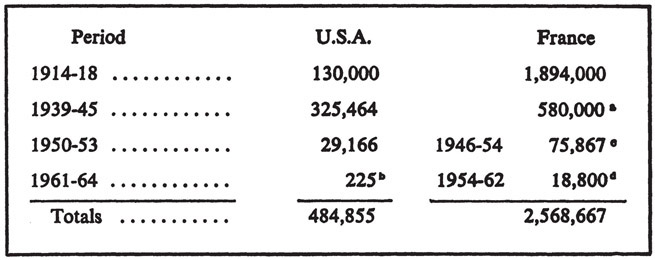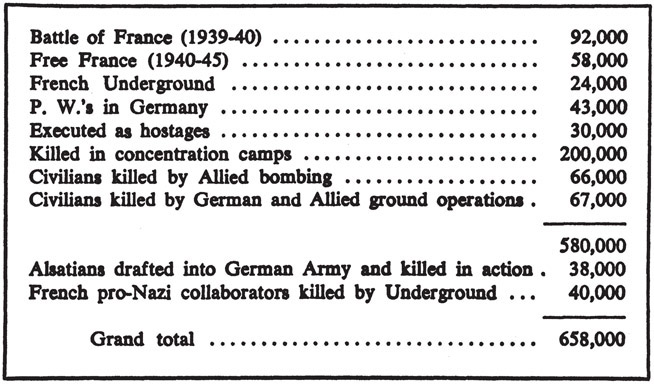Appendix I GLOSSARY OF ABBREVIATIONS
Note: French abbreviations in most cases carry periods between the capital letters, while American abbreviations do not. For the sake of simplicity, periods have been omitted here in all cases.
Appendix II COMPARISON BETWEEN FRENCH AND U. S. LOSSES
FRENCH AND AMERICAN LOSSES, INDOCHINA AND KOREA
FRENCH AND AMERICAN LOSSES (KILLED ONLY) SINCE 1914
a. See table on following page.
b. Laos and South Viet-Nam.
c. Does not include French losses in Korea.
d. Algeria.
STREET WITHOUT JOY FRENCH LOSSES DURING WORLD WAR II
Appendix III REPORT ON VIET-NAM
[Note: The following report on the situation in Viet-Nam was presented to the annual meeting of the Association of the U.S. Army in Washington on October 23, 1963 (i.e., eight days before the overthrow of the Diem regime by the Vietnamese Army), by Brigadier General Frank A. Osmanski, J-4 of MAC-V at the time. The text is as introduced in the Congressional Record of November 6, 1963, with the exception of about twenty words referring to a short film. I have added footnotes where I felt that the text needed amplification or contained what, in my view, constitutes factual errors.B.B.F.]
This report on Vietnam will be neither profound nor prophetic but the optimism it will reflect sincerely is genuinely that of General Harkins, whose greetings I am charged to bring to this conference.
General Collins has explained the strategic importance of the Republic of Vietnam.
I shall report on the military situation there, under four headings: Terrain, Weather, and Enemy; Friendly Forces; Counter-Insurgency Strategy and Tactics; and Results to Date.
TERRAIN, WEATHER, AND ENEMY
The Republic of Vietnam comprises three terrain regions: the central highlands, the central lowlands, and the Mekong Delta. The highlands are virgin country with tropical rain and bamboo forests and a broad grassy plateau at their center; inhabited by mountain migratory tribesmen; with a climate conducive to tea, coffee, and a little rice. The lowlands are a generally dry coastal plain with sand dune growths; a sedentary agrarian people; and insufficient rice for lack of water. The delta has bountiful rice paddies, a coastline of mangrove swamps, a central plain of reeds, and a maze of canals; is peopled by scattered rice-farmers and fishermen; and its heavy seasonal rainfall causes annual flooding. The nature of the counter-insurgency is vastly different in each of these regions.
The weather in the Republic of Vietnam is hot and humid, with two distinct seasons, wet and dry, which vary by region in response principally to two monsoons annually. Rainfall and sunshine are alternately intense, temperatures average 80 Fahrenheit, and there are about 10 typhoons a year and frequent high winds.
The enemy is the Vietcong, the VC, meaning Vietnamese Communist, for which cadres and arms caches were left behind are outfitted in khaki twill with steel or bamboo helmets and carry modern United States or bloc-country arms. Guerrillas wear the standard dress of the Vietnamese peasant, black cotton or satin pajamas, and carry obsolescent French or self-manufactured weapons. Porters wear as little as a loincloth and are unarmed. VC nonexplosive weapons include caltrops, spike-traps, poisoned darts, and even enraged water buffaloes. In a sense their physical endurance, patience, and ingenuity are also VC weapons, for they have been known to live in dark tunnels for weeks, to remain underwater for long periods by breathing through hollow reeds, and to lie in ambush for as long as 48 hours. The VC wage their war from their ancestral strongholds in the U Minh Ha Forest, Plaine des Jones, war zones C and D, and the Do Xa area; and from trackless provinces which they dominate, myriad small hidden bases, deep caves and long tunnels, and other safe havens. VC-initiated incidents are of four types; propaganda, terrorism, sabotage, and armed attacks. Their logistic support is from five sources: levy on the peasantry, import from other countries, capture from Government of Vietnam (GVN) forces, local purchase, and self-production.
FRIENDLY FORCES
The Republic of Vietnam Armed Forces (RVNAF) consist of a regular army, air force, and navy (including a marine corps) and three paramilitary forces: the civil guard, self-defense corps, and special forces. In addition there are the civilian irregular defense groups (CIDG), including hamlet militia, mountain scouts, border surveillance units, and trail watchers; and then such semiautonomous but gun-bearing patriotic organizations as the Republican Youth, Catholic Youth, and Womens Solidarity Movement. Assisting and advising these are the U.S. Military Assistance Command of about 14,000 and a small Australian Army Training Team.
STRATEGY AND TACTICS
The strategy of the counter-insurgency is three-pronged: the strategic hamlet program, field operations, and psychological operations and civic action.
These three methods intermingle. In essence, the strategy is to win battles and to win people.
The strategic hamlet program is the Republic of Vietnams national program to physically and ideologically separate the people from the VC and to win their support and confidence by providing them security, democratic government, and social and economic development. The program consists of (1) clear and hold operations, (2) province rehabilitation, and (3) portions of the CIDG program.
Clear and hold operations clear the VC from, and deny them, a specified area intended as the site of a strategic hamlet.
Province rehabilitation executes Province-prepared and nationally approved civil-military plans providing financial and supply support for the establishment of strategic hamlets.
Those portions of the CIDG program associated with the strategic hamlet program are designed to develop home-defense units for strategic hamlets.
Strategic hamlets, originally conceived as a defense against VC attack, now have become a means for effecting political, economic, and social progress. The Government of Vietnam has recognized this development and considers that the strategic hamlet is primarily the point of impact of a political and social revolution which will serve as a foundation for economic progress.
Field operations are directed variously at securing sites for strategic hamlets, destroying the VC logistic structure, killing or capturing VCs, or gaining or regaining control of Government of Vietnam territory. They are of three basic types:
(1) Clear and hold operations, executed in direct support of the strategic hamlet program, with the mission to clear an area of, and deny it to, the VC during the construction phase of a strategic hamlet.
(2) Fix and destroy operations, based on specific intelligence, with the mission to contact and destroy VC forces or installations; and


